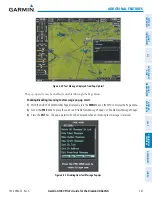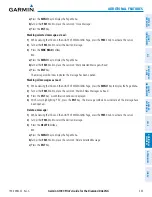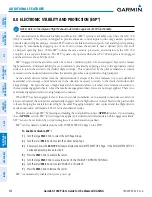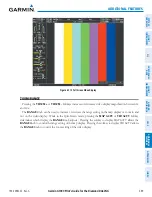
190-00962-02 Rev. A
Garmin G1000 Pilot’s Guide for the Diamond DA42NG
559
ADDITIONAL FEATURES
SY
STEM
O
VER
VIEW
FLIGHT
INSTRUMENTS
EIS
AUDIO P
ANEL
& CNS
FLIGHT
MANA
GEMENT
HAZARD
AV
OID
ANCE
AFCS
ADDITIONAL
FEA
TURES
APPENDICES
INDEX
With ESP
™
engaged, and the aircraft in a nose-up condition, opposing force steadily decreases from 20
°
nose-
up to 10
°
nose-up as aircraft pitch moves toward zero degrees. ESP
™
disengages at 10
°
nose-up. With ESP
™
engaged, and the aircraft in a nose-down condition, opposing force steadily decreases from 23
°
nose-down to
13
°
nose-down as aircraft pitch moves toward zero degrees. ESP
™
disengages at 13
°
nose-down.
The opposing force increases or decreases depending on the pitch angle and the direction of pitch travel. This
force is intended to encourage movement in the pitch axis in the direction of the normal pitch attitude range
for the aircraft.
There are no indications marking the pitch ESP
™
engage and disengage limits in these nose-up/nose-down
conditions.
Figure 8-102 ESP Pitch Operating Range When Engaged
(Force Increases as Pitch Increases & Decreases as Pitch Decreases)
30˚
25˚
20˚
15˚
10˚
5˚
0˚
5˚
10˚
15˚
20˚
25˚
30˚
30˚
25˚
20˚
15˚
10˚
5˚
0˚
5˚
10˚
15˚
20˚
25˚
30˚
35˚
40˚
45˚
50˚
35˚
40˚
45˚
50˚
50˚
45˚
40˚
35˚
50˚
45˚
40˚
35˚
ESP
ESP
HIGH AIRSPEED PROTECTION
Exceeding Vne will result in ESP
™
applying force to raise the nose of the aircraft. When the high airspeed
condition is remedied, ESP
™
force is no longer applied.








































